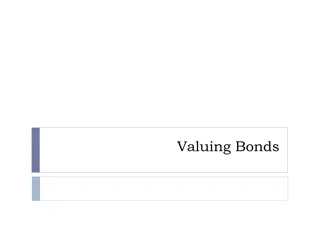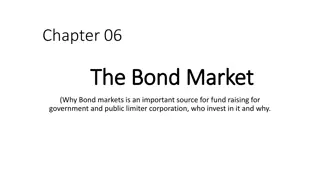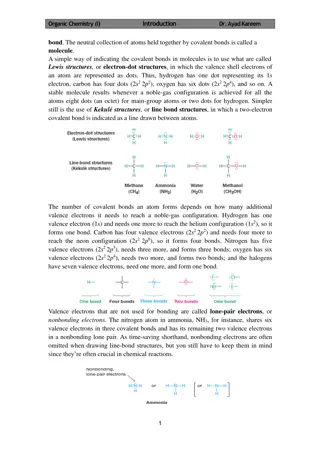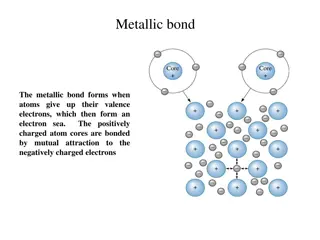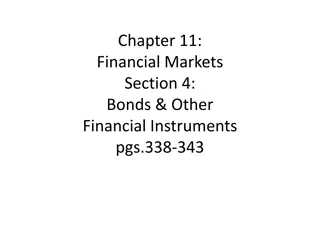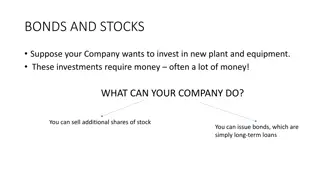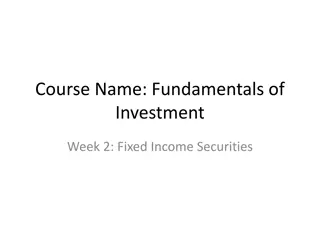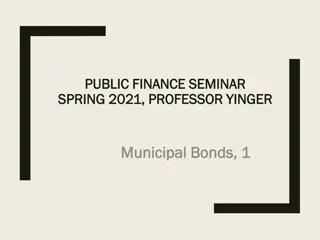
Role of Municipal Bonds in State and Local Public Finance
Explore the significance of municipal bonds in state and local public finance, understanding their characteristics, types, and impact on local economies. Delve into bond markets, bonds' relationship with taxes, and fees, and the real impact of bonds on financing capital projects over time.
Download Presentation

Please find below an Image/Link to download the presentation.
The content on the website is provided AS IS for your information and personal use only. It may not be sold, licensed, or shared on other websites without obtaining consent from the author. If you encounter any issues during the download, it is possible that the publisher has removed the file from their server.
You are allowed to download the files provided on this website for personal or commercial use, subject to the condition that they are used lawfully. All files are the property of their respective owners.
The content on the website is provided AS IS for your information and personal use only. It may not be sold, licensed, or shared on other websites without obtaining consent from the author.
E N D
Presentation Transcript
State and Local Public Finance State and Local Public Finance Professor Yinger Professor Yinger Spring 2022 Spring 2022 LECTURE 13 BOND MARKETS
State and Local Public Finance State and Local Public Finance Lecture 13: Bond Markets Lecture 13: Bond Markets Class Outline The Role of Municipal Bonds Characteristics of a Bond Types of Bonds Bond Markets
State and Local Public Finance State and Local Public Finance Lecture 13: Bond Markets Lecture 13: Bond Markets Class Outline The Role of Municipal Bonds Characteristics of a Bond Types of Bonds Bond Markets
State and Local Public Finance State and Local Public Finance Lecture 13: Bond Markets Lecture 13: Bond Markets Municipal Bonds Today s topic is state and local bonds, usually lumped together as municipal bonds or munis. This is an important topic because financing capital projects without borrowing would cause huge short-run shocks to state and local tax rates. Borrowing allows a jurisdiction to spread the impact of large capital projects over time.
State and Local Public Finance State and Local Public Finance Lecture 13: Bond Markets Lecture 13: Bond Markets Bonds and Taxes or Fees Municipal bonds are a burden-spreading tool; they cannot pay for public projects by themselves. In order to pay for a project, a government must come up with sufficient taxes or fees and then spread the impact out over time with bonds. Decisions about bonds therefore are connected to decisions about the best way to pay for a project, that is, about the most appropriate taxes and fees (based on equity and efficiency).
State and Local Public Finance State and Local Public Finance Lecture 13: Bond Markets Lecture 13: Bond Markets The Real Impact of Bonds Saying that bonds are a burden-spreading tool does not imply that they have no real impacts. In fact, there is a cost to spreading out the impact of a project over time, namely, interest costs, broadly defined. Poor bond-issuing policies can boost interest costs above the minimum required level.
State and Local Public Finance State and Local Public Finance Lecture 13: Bond Markets Lecture 13: Bond Markets Overview of the Muni Bond Market In 2019, state and local governments issued $317.7 billion of tax-exempt municipal debt, $67.3 billion of taxable municipal debt, and $21.6 billion of private-purpose debt (which is subject to the federal alternative minimum tax). These long-term issues were accompanied by $45.7 billion of short-term debt. o We will cover the issue of taxability in the next class. This debt was used to spread out the burden of paying for, among other things, general purpose projects, K-12 schools, higher education, utilities, hospitals, mass transit, tunnels, housing, and airports. For more information, see https://www.sifma.org/wp-content/uploads/2020/01/US-Municipal-Issuance-Survey-2020-01-14- SIFMA.pdf
State and Local Public Finance State and Local Public Finance Lecture 13: Bond Markets Lecture 13: Bond Markets Overview of the Muni Bond Market
State and Local Public Finance State and Local Public Finance Lecture 13: Bond Markets Lecture 13: Bond Markets Class Outline The Role of Municipal Bonds Characteristics of a Bond Types of Bonds Bond Markets
State and Local Public Finance State and Local Public Finance Lecture 13: Bond Markets Lecture 13: Bond Markets What is a Municipal Bond? A bond is a certificate of indebtedness. The issuer agrees to pay interest to the purchaser in return for the use of the purchaser s money over a given period of time. A bond contrasts with a stock, in which a firm exchanges part ownership in a company for the use of an investor s money. Stocks are not relevant for government.
State and Local Public Finance State and Local Public Finance Lecture 13: Bond Markets Lecture 13: Bond Markets Basic Bond Characteristics Three things are always stamped on a bond: 1.Face Value = F(= par value or redemption value or value at maturity). 2.Coupon Rate = c, which indicates the interest to be paid as a percentage of F and which can be either fixed or floating (i.e. tied to some other rate). 3.Years to Maturity = N, which is the number of years until the bond can be redeemed and is also the number of years during which the investor is entitled to collect interest.
State and Local Public Finance State and Local Public Finance Lecture 13: Bond Markets Lecture 13: Bond Markets Basic Bond Characteristics, 2 Bonds are usually issued in serial form, which means that some bonds have N=1, some have N=2, some have N=3, all the way up to the highest selected maturity, N*. o This approach helps spread out the cost because it implies that only 1/N* of the bonds have to be paid back each year. Bonds are usually issued with face values of $5,000 or multiples of $5,000. o In the past, this meant that only large investors bought them, but now anyone can invest any amount in bonds through a bond fund.
State and Local Public Finance State and Local Public Finance Lecture 13: Bond Markets Lecture 13: Bond Markets Basic Bond Characteristics, 3 Other things that might be on a bond: o Call Option, which gives the issuer the right to recall the bond before its maturity date (increasing the risk placed on the investor). o Put Option, which allows the investor to redeem the bond before its maturity date (increasing the risk placed on the issuer). o Insurance against the possibility that the issuer cannot make the specified payments on time (lowering the risk placed on the investor but imposing a cost on the issuer).
State and Local Public Finance State and Local Public Finance Lecture 13: Bond Markets Lecture 13: Bond Markets The Price of a Bond The first key to understanding bond markets is to think about the market price of a bond. This price equals the amount an investor would pay to purchase a bond. This market price is not the same thing as a bond s face value!!
State and Local Public Finance State and Local Public Finance Lecture 13: Bond Markets Lecture 13: Bond Markets The Price of a Bond, 2 Suppose an investor has an alternative, similar investment, perhaps a U.S. Treasury Bill, that offers an interest rate r. Then ris the opportunity cost of investing in bonds, and the investor s willingness to pay is the present value of the benefits from holding the bond or cF cF P r r + + cF + F = + + + + ... (1 ) + N N 2 (1 ) (1 ) (1 ) r r
State and Local Public Finance State and Local Public Finance Lecture 13: Bond Markets Lecture 13: Bond Markets The Price of a Bond, 3 With the help of a little algebra, this equation can be simplified to: + 1 (1 + N ) 1 r = P F c + N (1 ) r r The 1st term is like a mortgage (where P is the mortgage amount and cF is the monthly payment), but a bond, unlike a mortgage, retains its principal until it is redeemed (the 2nd term). See the posted notes on present value and discounting for more.
State and Local Public Finance State and Local Public Finance Lecture 13: Bond Markets Lecture 13: Bond Markets The Price of a Bond, 4 Thus, regardless of the split between interest (the 1st term) and redemption value (the 2nd), P is proportional to F. o If P > F, the bond is said to sell at a premium; o if P < F, the bond is said to sell at a discount.
State and Local Public Finance State and Local Public Finance Lecture 13: Bond Markets Lecture 13: Bond Markets A Bond s Rate of Return The second key to understanding bond markets is to think about the rate of return on a bond that sells at price P. This rate of return is the value of r at which the above equation is true, given P. This is a standard type of present-value calculation; it is often called finding the internal rate of return. In the case of bonds, it is called calculating a bond s yield to maturity.
State and Local Public Finance State and Local Public Finance Lecture 13: Bond Markets Lecture 13: Bond Markets Calculating Yield to Maturity Calculating the yield to maturity is difficult because the equation is nonlinear. But most spreadsheet programs are set up to do this type of calculation, that is, to find an internal rate of return (IRR). Intuitively, these programs determine the sum of a bond s interest return and its capital appreciation per year.
State and Local Public Finance State and Local Public Finance Lecture 13: Bond Markets Lecture 13: Bond Markets Price and Rate of Return The difference between these two ways of looking at bonds (price and rate of return) corresponds to what is unknown. o In the first case r is known, butPis not. We use the present-value equation to solve for P. o In the second case, P is known, but r is not. We use the present- value equation to solve for r.
State and Local Public Finance State and Local Public Finance Lecture 13: Bond Markets Lecture 13: Bond Markets Questions What features are always posted on a municipal bond? What are call and put options? What is bond insurance? What is the price of a bond? What is the annual return on a bond?
State and Local Public Finance State and Local Public Finance Lecture 13: Bond Markets Lecture 13: Bond Markets Class Outline The Role of Municipal Bonds Characteristics of a Bond Types of Bonds Bond Markets
State and Local Public Finance State and Local Public Finance Lecture 13: Bond Markets Lecture 13: Bond Markets Types of Bonds Bonds come in many different types, including: Refunding Bond When interest rates drop, a government with outstanding bonds may pay them off and issue new bonds at a lower rate. This is only possible with a call option (which may kick in after a specified waiting period). The government issues refunding bonds at a rate lower than the original and uses the proceeds to pay off the original bond issue. These bonds were common but have dropped off considerably since 2017 when the TCJA (tax bill) made their interest taxable.
State and Local Public Finance State and Local Public Finance Lecture 13: Bond Markets Lecture 13: Bond Markets Types of Bonds, 2 See: https://www.sifma.org/wp-content/uploads/2020/01/US- Municipal-Issuance-Survey-2020-01-14-SIFMA.pdf
State and Local Public Finance State and Local Public Finance Lecture 13: Bond Markets Lecture 13: Bond Markets Types of Bonds, 3 Some bonds are counter-intuitive. Zero Coupon Bond = a bond that pays no interest. This bond obviously must sell at a huge discount (P < F) because all of its return comes in the form of a capital gain. o Its price: F = Zero-coupon bond: P + )N (1 r
State and Local Public Finance State and Local Public Finance Lecture 13: Bond Markets Lecture 13: Bond Markets Types of Bonds, 4 Compound Interest Bond or Capital Appreciation Bond = a bond that puts interest payments in an account and lets them accumulate but does not pay them out until the maturity date. This bond changes the time pattern of payments by saving all the interest until the end. o Its price: + + N (1 (1 ) ) c r = CAB: P F N o If c = r, then P = F.
State and Local Public Finance State and Local Public Finance Lecture 13: Bond Markets Lecture 13: Bond Markets Types of Bonds, 5 Some budget officials like zero-coupon or capital appreciation bonds because they push the re-payment streams into the future and hence make it easier to balance the budget today. These bonds do not save money, however, because they do not change the present value of the re-payment stream. Moreover, zero-coupon bonds are generally avoided near a borrowing limit because they have the highest face values.
State and Local Public Finance State and Local Public Finance Lecture 13: Bond Markets Lecture 13: Bond Markets Types of Bonds, 6 The following table shows the actual payments and the present value of payments for standard, zero-coupon, and capital-appreciation bond serial issues, each with a present value of $50,000. Actual payments are the budget amounts for interest and redemption. The present value columns account for the fact that payments made in the future have a lower true impact than payments made today. Bond decisions should be based on present values unless the issuer faces external constraints!
State and Local Public Finance State and Local Public Finance Lecture 13: Bond Markets Lecture 13: Bond Markets Types of Bonds, 7 Table 1. Payments on Three Types of Municipal Bond Zero-Coupon Standard Capital Appreciation Year Actual $7,500.00 $7,250.00 $7,000.00 $6,750.00 $6,500.00 $6,250.00 $6,000.00 $5,750.00 $5,500.00 $5,250.00 Present Value $7,142.86 $6,575.96 $6,046.86 $5,553.24 $5,092.92 $4,663.85 $4,264.09 $3,891.83 $3,545.35 $3,223.04 Actual $6,475.23 $6,475.23 $6,475.23 $6,475.23 $6,475.23 $6,475.23 $6,475.23 $6,475.23 $6,475.23 $6,475.23 Present Value $6,166.88 $5,873.22 $5,593.55 $5,327.19 $5,073.51 $4,831.92 $4,601.82 $4,382.69 $4,173.99 $3,975.23 Actual $5,250.00 $5,512.50 $5,788.13 $6,077.53 $6,381.41 $6,700.48 $7,035.50 $7,387.28 $7,756.64 $8,144.47 Present Value $5,000.00 $5,000.00 $5,000.00 $5,000.00 $5,000.00 $5,000.00 $5,000.00 $5,000.00 $5,000.00 $5,000.00 1 2 3 4 5 6 7 8 9 10 Total $63,750.00 $50,000.00 $64,752.29 $50,000.00 $66,033.94 $50,000.00 Note: The coupon rate and opportunity cost are set at 5%. The table presents the total payments on bonds of all maturities in each year. The face values of the standard and capital appreciation bonds are $5,000; the face values of the zero-coupon bonds are $6,475.23. The standard and capital appreciation bonds sell for $5,000, whereas the zero-coupon bonds sell for amounts between $4,761.91 (1-year maturity) and $3,069.57 (10-year maturity). Note that CABs have illusory savings (=lower payments) in the first few years but the same present value overall!.
State and Local Public Finance State and Local Public Finance Lecture 13: Bond Markets Lecture 13: Bond Markets Types of Bonds, 8 Perpetuity = a bond with N = , so it just pays interest and never gets to the redemption date. Perpetuities aren t used often because they put a perpetual burden on government. But they are interesting to evaluate. o With an infinite N, the present-value formula simplifies to: cF r = P o So if c = r, then P = F; if c< r, the bond sells at a discount (P < F); and if c > r, the bond sells at a premium. Discounts and premiums can arise even if a bond never matures!
State and Local Public Finance State and Local Public Finance Lecture 13: Bond Markets Lecture 13: Bond Markets Types of Bonds, 9 Although perpetuities are rare, a case of bonds with very long maturities appeared in The New York Times a couple years ago. In 1868, Winston Churchill s grandfather, Leonard W. Jerome, came up with the idea of building a road to a new racetrack in what is now the Bronx. Two villages issued the bonds at a 7% interest rate and with maturities up to 279 years; the resulting street was initially called Central Avenue, but it is now called Jerome Avenue. When NYC annexed these villages, it inherited the bonds and will keep paying 7% interest to remaining bondholders until the last bond is redeemed in 2147! See: http://www.nytimes.com/2009/02/13/nyregion/13jerome.html
State and Local Public Finance State and Local Public Finance Lecture 13: Bond Markets Lecture 13: Bond Markets Categories of Municipal Bond Bonds backed by full taxing authority of issuing government o General Obligation Bonds (GO) o Moral Obligation Bonds o Double Barreled GO Bonds Bonds backed by Specific Revenue Source o Revenue Bond o Agency Bond o Tax Increment Bond
State and Local Public Finance State and Local Public Finance Lecture 13: Bond Markets Lecture 13: Bond Markets Categories of Municipal Bond, Continued Bonds backed by a private revenue source o Industrial Development Bonds o Pollution Control Bonds o Mortgage Revenue Bonds Bonds to smooth timing problems or lock in lower rates o Tax Anticipation Notes (TANs) o Revenue Anticipation Notes (RANs) o Bond Anticipation Notes (BANs) o Advance Refunding Bond (proceeds held more than 90 days)
State and Local Public Finance State and Local Public Finance Lecture 13: Bond Markets Lecture 13: Bond Markets Investments that Compete with Bonds Governments must compete for investor s funds with many other types of investment, including: o Stocks o Corporate Bonds o Federal Bonds (savings bonds, Treasury bonds, agency bonds) o Mortgages
State and Local Public Finance State and Local Public Finance Lecture 13: Bond Markets Lecture 13: Bond Markets Class Outline The Role of Municipal Bonds Characteristics of a Bond Types of Bonds Bond Markets
State and Local Public Finance State and Local Public Finance Lecture 13: Bond Markets Lecture 13: Bond Markets The Market for Tax-exempt Loanable Funds Demand: State and local governments want loanable funds to smooth revenue flows Supply: Investors with high marginal tax rates prefer tax-exempt investments, such as munis, for reasons explored next class.
State and Local Public Finance State and Local Public Finance Lecture 13: Bond Markets Lecture 13: Bond Markets Purchasers of Munis For reasons discussed in the next class, the purchasers of munis are mostly high-income individuals, mutual funds, banks, and insurance companies. According to www.sifma.org: o The share of munis owned by high-income individuals went from 11.8% in 1996 to 42.5% in 2017. o The shares for mutual funds are 11.8% in 1996 and 24.6% in 2017; the shares for commercial banks are 2.8% in 1996 and 15.4% in 2017; and the shares for insurance companies are 4.9% in 1996 and 13.4% in 2017.
State and Local Public Finance State and Local Public Finance Lecture 13: Bond Markets Lecture 13: Bond Markets The Market for Municipal Bonds i = interest rate = yield to maturity S = Lending D = Borrowing $s of Loanable Funds
State and Local Public Finance State and Local Public Finance Lecture 13: Bond Markets Lecture 13: Bond Markets The Market for Municipal Bonds, 2 S = Borrowing P = Price of a Bond D = Lending Number of Bonds
State and Local Public Finance State and Local Public Finance Lecture 13: Bond Markets Lecture 13: Bond Markets Impact of Tight Monetary Policy Impact of Tight Monetary Policy (or loss of confidence in (or loss of confidence in munis munis or new tax or new tax- -exempt savings options) exempt savings options) The Market For Municipal Bonds S2 i S1 = Lending i2 i1 D = Borrowing $s of Loanable Funds
State and Local Public Finance State and Local Public Finance Lecture 13: Bond Markets Lecture 13: Bond Markets Initial Impact of Industrial Development Bonds Initial Impact of Industrial Development Bonds (or Mortgage Revenue Bonds) (or Mortgage Revenue Bonds) The Market For Municipal Bonds S = Lending i i2 i1 D2 D1 = Borrowing $s of Loanable Funds
State and Local Public Finance State and Local Public Finance Lecture 13: Bond Markets Lecture 13: Bond Markets Questions What is a zero coupon bond? What is a perpetuity? What is a compound interest bond? Why might a public official prefer a standard bond over an equal-cost zero-coupon bond? Why does the federal government limit the volume of untaxable municipal bonds?


